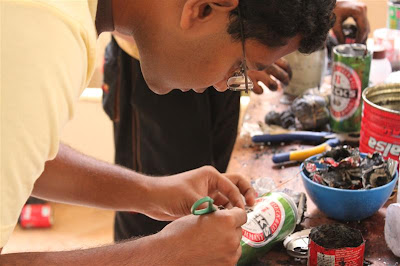
The last week has been spent in the workshops, as teams finally had the chance to start building their prototypes. There has been some awesome progress made by all of the teams and there are individual project team updates on their way to the blog, very soon. So much has happened this week, and I’ve only got thirty minutes before we depart for the villages so as such this entry will be mainly picture based, but I’ll squeeze in as much description as possible!
Amy reminded the teams on Monday morning that a change in thought process was needed if they were to meet the deadline of having a first prototype ready for the village visits, due to take place on 3rd to 5th August. She told them to choose their approach, their workshop and just start building! She set about outlining some case studies which she felt could help the participants in understanding the following six aspects that should inform each of their designs:
Design for Affordability
Design for Usability
Design for Sustainability
Design for Manufacturability
Design for Re-use
Design for Failure
Amy and Ben went through each of these aspects of appropriate technology design individually and meticulously, but it was the final one, design for failure, that Amy stressed as the most important. She said that understanding that your device will fail is crucial and after that it’s all about trying to figure out when it will fail first, how it will fail, and then figuring out the best and worst failure modes and then trying to plan and design for the former. For example, if a part fails that can only be fixed by a blacksmith, then it becomes difficult for the villagers to service the device themselves, and thus it can become redundant pretty quickly. Despite all of this advice, Amy pressed home the point that there is no fail safe approach in design, “there are no solutions, only trade offs”.
 The Shea team discuss the specifications of their design
The Shea team discuss the specifications of their designLater in the week, Ela Ben-Ur followed on from Amy’s presentation, giving an interactive session on the importance of User Based Design. The session was based on up-skilling the teams in how to get constructive user feedback on their prototypes, ahead of their village visits later in the week. If designs are to be accepted by the customer, it is crucial that they have some input into the design process as nobody knows better than they the nuances behind the everyday problems they face in their lives. Ela experimented with the group in the different ways you can gather feedback (a tech fair, smaller sessions, individual interviews etc) and she could not stress enough how important is the process of setting the stage just right, introducing the project and the idea just enough, and then letting the users come the extra mile themselves, so they really understand it and have a stake in it. Most importantly, “get the prototype out of your own hands!”
This was followed by our final session from Paul Hudnut, as he instructed us to think “Who really wants this?”. Determining just who your final product is aimed at (Nurses, Health Clinic, UN, EHO, villagers etc) is crucial and should constantly inform the design process. Paul told us that it’s all very well inventing things, but if you don’t market it you become a collector, rather than a disseminator. Thinking about scale is another element which needs to be at the forefront of the design process, he said. To help the participants understand where he was coming from, Paul introduced the concept of a proto-venture.The rest of the week was thankfully spent in the workshops, actually building things!


 Jess, of the Chlorine Production team, and Daniel, of the Shea Oil Extraction group, help each other out in the workshop
Jess, of the Chlorine Production team, and Daniel, of the Shea Oil Extraction group, help each other out in the workshop 


















1 comment:
Fantastic shirts - where can I get one ;-)
Looking forward to the group updates!
Post a Comment